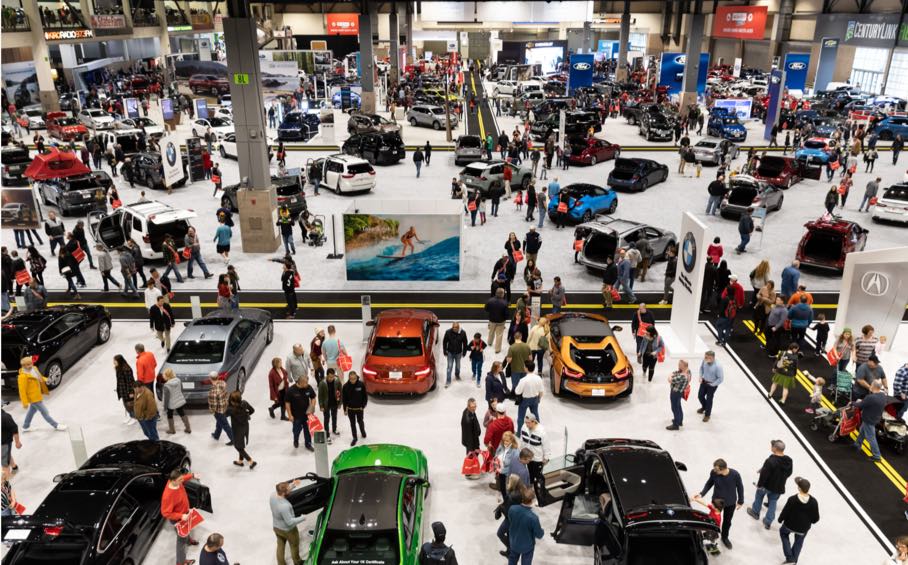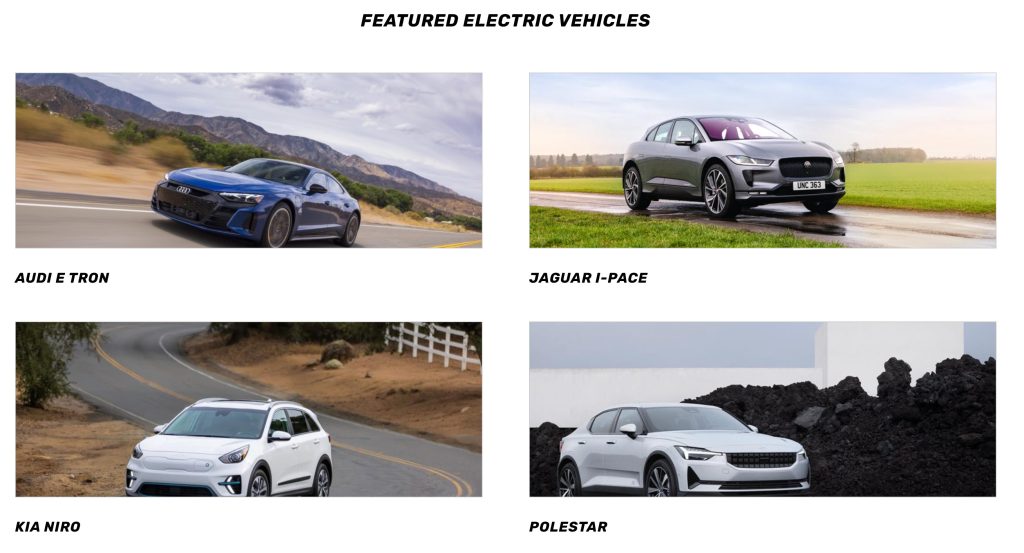Merriam-Webster defines technology as “the use of science in industry and engineering to invent useful things or to solve problems.” Automobiles are the very embodiment of that definition. From aerodynamic design to automated driver assistance to the conversion of new sources of energy into propulsion, and striking new examples of the human-to-auto interface, today’s vehicles are the most advanced consumer products on the planet, bar none.

As the cloud of Covid has lifted over Lumen Field, from the NFL gridiron to the Lumen Field Event Center, the Seattle International Auto Show offered the chance to get hands-on with the latest generation in automotive technology. More than 350 of the latest model cars, trucks, SUVs, crossovers, vans, electric vehicles, hybrids and exotics went on display and dozens more made available to test drive.
We tapped into the mind of automotive expert Tom Voelk of YouTube’s Driven Car Reviews for an overview of what was the most electrifying at the show.
Seattle24x7: Let’s get behind the wheel of this year’s Seattle International Auto Show, Tom. All puns intended — this milestone in automotive engineering has really brought us to a crossroads.

Voelk: It’s hard to overstate how sophisticated the automobile has become in the last five years and much of the revolution is focused on safety. It starts with what engineers use to create the vehicles. Computer Aided Design, or CAD, has been used for decades to create the shared architectures underneath cars and trucks. These techniques have become significantly more powerful. General Motors’ new CAD methods accelerated the Cadillac Lyriq EV development by nine months.
Seattle24x7: We’re also witnessing a new generation in materials.
Voelk: The design process has also helped place stronger materials where they’re needed and virtually tuned the aerodynamics. The reduced weight and wind cheating surface has added range without a larger battery. All cars now are “crash tested” hundreds if not thousands of times virtually before a physical vehicle is built. This allows engineers to tweak the structure for maximum protection and gives us safer cars at lower prices.
For example, the next generation Toyota Tundra rides on a new frame. An exclusive process laser welds a jigsaw puzzle-like arrangement made of multiple grades of steel to form a fully boxed beam. This puts strong materials where needed, and lightness where it’s not so the frame is 10 percent lighter and 20 percent more rigid. Together with a new rear coil suspension, ride quality is significantly improved. And it’s safer in a crash.
Seattle24x7: Safety seems to have reached a whole new standard.
Voelk: It’s common to find even budget-minded vehicles under $25,000 with automatic emergency braking being the standard. Kia Soul and Forte, Volkswagen Jetta and Toas, Hyundai Elantra and Venue, Nissan Sentra and Kicks plus many more have made it the standard to keep you (and others) safe. This was once exclusive to the far more expensive Volvo XC60. Now, all Subarus come standard with the company’s EyeSight system that provides lane keeping assist, automatic braking with pedestrian detection and adaptive cruise control that matches the speed of the car ahead.
Most manufacturers have made these kinds of systems standard across much of their lineups (or as an extremely affordable option). Also, look for cross path detection that, when backing up in a parking lot, alerts a driver to unseen cars approaching from the side. Some systems brake to avoid a collision. The new Lexus NX uses the blind spot monitoring sensors to detect cars or bicyclists that are coming from behind, then keeps the door from opening into them.
Seattle24x7: These human-machine advances seem to make driving a more pleasurable experience?
Voelk: Most cars are available with keyless ignition so digging through your pockets or purse to open and start your car is a thing of the past. Modern noise regulations cap the decibel level of exhaust notes. Piped-in sound, whether through a physical valve or electronically generated through speakers, give performance junkies the growl they love while keeping the streets a quieter place.
Screens seem to be taking over everywhere and the automobile is no different. Many vehicles are available with an LCD display that replaces the traditional gauge cluster. The advantage is you can rearrange it to your liking. Head up displays are also useful. Information like speed, traffic information, radio station and navigation prompts appear to float near the nose of the vehicle keeping the driver’s eyes on the road.
You’ll be talking to your cars more (no, not swearing) and they will respond. The last few years have brought much better natural language “voice assistant” interfaces inside the car, much like you would use Apple’s Siri, Google Assistant or Amazon Alexa. The latest from BMW, Lexus and Mercedes will respond to a prompt such as “hey Mercedes, I need a cup of coffee” with directions to three of the closest java spots. Saying “hey BMW, I’m cold” will turn up the climate control a few degrees and switch on the heated seats. Can’t afford a luxury vehicle? Nearly all cars come with Apple CarPlay or Android Auto that respond much the same way to get directions, send text messages and call up music.
Seattle24x7: Are we finally seeing the advent of full-stream Internet connectivity?
Voelk: General Motors has been aggressive in installing 4G LTE high-speed internet hotspots in its cars and more and more automakers are following its lead. For families that want to stream movies on the way to Grandma’s house, it easily handles multiple devices and the signal is much more robust than what your cell phone offers. Sure, it’s another monthly payment but you’ll never hear “are we there yet?” again.
Nearly all automakers have embraced over the air updates, or OTAs. Vehicles depend on sophisticated software for engine and transmission management. That code can be updated while you’re sleeping to increase efficiency, improve the user interface or even add new features. In some cases, you’ll be able to “rent” enhancements like lane keeping assist and adaptive cruise control for long trips.
Seattle24x7: You have a “Reality check” for us on fully autonomous vehicles?
Voelk: The fully autonomous car is years away from affordability. However, plenty of vehicles have semi-autonomous driving technology which can take gentle highway turns with confidence. Nissan’s ProPilot Assist is especially well done when it comes to affordability. Same with Hyundai’s and Kia’s Highway Driving Assist. True handsfree driving is possible with GM’s Super Cruise, Ford’s Blue Cruise and the upcoming Lexus Teammate. Unlike other systems, there’s little need to touch the steering wheel. I drove (or rather rode) a Cadillac from Tacoma to Portland, only touching the wheel and pedals once, and that was to pull off to a rest stop. And if you’ve never experienced automated parking, it’s faster and safer than most humans.

Seattle24x7: Besides the brains of these vehicles there is also considerable “beast mode,” to use a Seattle-borne expression, in terms of engines.
Voelk: Ford’s Mustang GT is equipped with a 5-liter V8 that pumps out 460 horsepower. But automakers are consistently dropping cylinders from internal combustion engines (or ICE) while keeping the same amount of power. How? Turbocharging. Ford eliminated the V6 from the Mustang line since the 2.3-liter EcoBoost 4-cylinder provides more power and better fuel economy.
Three-row crossovers such as Volvo XC90, Subaru Ascent and Mazda CX-9 move the family with 4-cylinder turbo power and do it quite well. Even Ford’s vaunted F-150 Raptor pickup ditches a V8 for a turbocharged 3.5-liter V6 rated at 450 horsepower and 510 lb-ft of torque. You won’t miss the extra cylinders. Really. And modern turbo engines are far more reliable than the units of just a decade ago.
Another engine feature you’ll encounter is automatic engine stop/start that employs a robust starting system for durability. At standstill the engine turns itself off. Lift off the brake pedal, nudge the wheel or touch the throttle and it automatically comes to life. It’s important to test drive this feature because some automakers apply it much more seamlessly than others. It’s easy to disable in most cars, which is good in stop and go traffic jams where it can become annoying.

Seattle24x7: What is happening with the hot-selling pickups?
Voelk: It’s tough to change the shape of a pickup but the automakers are doing heavy lifting to woo buyers. The GMC Sierra has a number of innovations. The molded CarbonPro box is 60 pounds lighter than traditional steel units due to solid composite carbon fiber construction. It allows for distinct useful shapes like divots for motorcycle wheels and slots for mounting boards. The material is easily recyclable (Northwesterners appreciate that kind of thing.) And the MultiPro Tailgate is now offered on both Sierra and Chevy Silverado. Its six different positions include a bed extender, a half-height tailgate and a step to get into the bed more easily. It’s worth stopping by the booth for a demonstration.
The Ram 1500 offers a unique eTorque system that’s standard on the 3.6-liter V6 and a $1450 option for the 5.7-liter Hemi V8. It’s a mild hybrid that increases torque and fuel efficiency plus smooths out the shifts of the 8-speed gearbox.
And there are plenty of electric pickups on the way. Ford F-150 Lightning and Chevy Silverado E will change the way things are done on the farm, and everywhere else. Look for them in 2022.
Seattle24x7: The “shape of things to come” is also changing.
Voelk: Compare a Honda Civic from the 1980’s and today’s all-new model and you’ll find the old car’s windshield was more upright. Most modern cars have dramatically swept front glass to gain aerodynamic efficiency. That and taller rumps add a couple of miles-per-gallon to a car’s fuel economy. Nowadays the measurement from the wheel arch to the top of the hood is much thicker. Bumpers have to be at a certain height to place any unfortunate struck soul onto the hood instead of under the car. Morbid yes, but think about that when staring at your phone in a crosswalk.
Because the car’s silhouette has become chunkier, designers have responded with larger wheels and tires for a more balanced profile. Keep in mind that trendy low-profile tires on 19 and 20-inch wheels give the car a rougher ride because they don’t have the cushioning ability of taller sidewalls. They don’t protect the alloy wheels from pothole impact as well either. Ask me how I know.

Seattle24x7: All in all, this seems like the year that marks the true emergence of the electric vehicle.
Voelk: This is the year electric vehicles start surging to the forefront. Currently (no pun intended) EVs make up just two percent of sales in the U.S. That should change significantly in the next few years. Scheduled to arrive in 2022 are Cadillac Lyriq, Volkswagen ID.4 AWD, Mercedes EQS, GMC Hummer SUV and pickup, Chevy Silverado E, Volvo XC40 and C40, Toyota bZ4X, Ford Mustang Mach-E GT, Kia EV6, and Hyundai Ioniq5 to name some.
Don’t forget about plug-in hybrids. These are vehicles that travel 12-50 miles or so on electric power only, then seamlessly switch to gasoline for longer trips. Most commuters only drive 30 miles a day and PHEVs like Toyota RAV4 Prime, Kia Sorento and Niro, Hyundai Tucson and Santa Fe, Chrysler Pacifica Hybrid minivan or Honda Clarity will cover that distance using no gas at all. My plug-in hybrid usually uses less than a tank a year since most of my city driving is done on electric power. Many manufacturers offer PHEVs, even Jeep. But remember, to make the technology green, you need to charge them.
Editor’s Note: A special attraction at the show was the Electric Highway, a display featuring about 10 of the latest EV/hybrid vehicles from Volvo, Jaguar, Porsche, VW, Audi, KIA, Toyota and more. And adjacent to that you could test drive EVs like the Porsche Taycan, VW ID.4, Jaguar I Pace, Polestar and Audi e-tron Quattro. Chargeway was also on display. [24×7]























